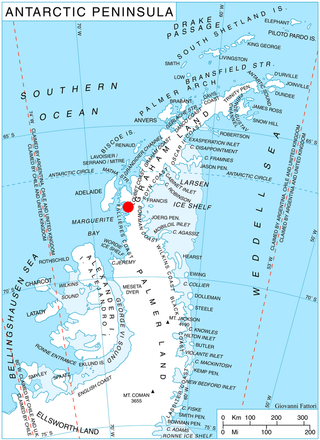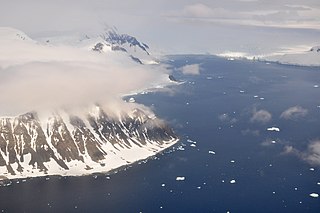Related Research Articles

Marguerite Bay or Margaret Bay is an extensive bay on the west side of the Antarctic Peninsula, which is bounded on the north by Adelaide Island and on the south by Wordie Ice Shelf, George VI Sound and Alexander Island. The mainland coast on the Antarctic Peninsula is Fallières Coast. Islands within the bay include Pourquoi Pas Island, Horseshoe Island, Terminal Island, and Lagotellerie Island. Marguerite Bay was discovered in 1909 by the French Antarctic Expedition under Jean-Baptiste Charcot, who named the bay for his wife.

The Usarp Mountains are a major Antarctic mountain range, lying west of the Rennick Glacier and trending north to south for about 190 kilometres (118 mi). The feature is bounded to the north by Pryor Glacier and the Wilson Hills.
Willey Glacier is a heavily crevassed glacier north of Creswick Peaks in Palmer Land, flowing west from Creswick Gap into George VI Sound. Named by United Kingdom Antarctic Place-Names Committee (UK-APC) for Lawrence E. Willey, British Antarctic Survey (BAS) geologist at Fossil Bluff and Stonington Island stations, 1966–69 and 1973, and awarded the Polar Medal for services to Antarctic Survey in 1976.
Bertram Glacier is a glacier, 15 nautical miles (28 km) long and 18 nautical miles (33 km) wide at its mouth, which flows west from the Dyer Plateau of Palmer Land into George VI Sound between Wade Point and Gurney Point.

Bucher Glacier is a small glacier draining the west slopes of Rudozem Heights and flowing to Bourgeois Fjord just north of Bottrill Head on the German Peninsula, Fallières Coast on the west side of Graham Land, Antarctica. It was named by the UK Antarctic Place-Names Committee in 1958 for Edwin Bucher, Swiss glaciologist and author of many publications on snow and avalanches.

Cole Channel is a marine channel running north–south between Wright Peninsula, Adelaide Island, and Wyatt Island, Laubeuf Fjord, off the Loubet Coast, Antarctica. It was named by the UK Antarctic Place-Names Committee in 1984 after Captain Maurice John Cole, Senior Master of the British Antarctic Survey ship Bransfield from 1975. Cole did previous Antarctic service as an officer on the John Biscoe and the Shackleton, for several seasons between 1960 and 1972.
Nemo Glacier is a glacier flowing east into Nemo Cove, Pourquoi Pas Island, in northeast Marguerite Bay. Named by United Kingdom Antarctic Place-Names Committee (UK-APC), 1979, in association with Nemo Cove.
Jennings Reef is a reef, mostly submerged, extending between Avian Island and the Rocca Islands, off the south end of Adelaide Island, Antarctica. It was named by the UK Antarctic Place-Names Committee for Leading Seaman Ronald A.J. Jennings, the coxswain of the survey motorboat Quest, used by the Royal Navy Hydrographic Survey Unit which charted the feature in 1963.

Demorest Glacier is a glacier on the northeast side of Hemimont Plateau which flows southeast into Whirlwind Inlet between Flint Glacier and Matthes Glacier, on the east coast of Graham Land. It was discovered by Sir Hubert Wilkins on a flight of December 20, 1928, and photographed from the air by the United States Antarctic Service in 1940. It was charted by the Falkland Islands Dependencies Survey in 1947 and named for Max H. Demorest, an American glaciologist.
Dennison Reef is a reef between the Shull Rocks and the Pauling Islands, lying east of the south end of the Biscoe Islands in Crystal Sound. It was mapped from air photos obtained by the Ronne Antarctic Research Expedition (1947–48) and from surveys by the Falkland Islands Dependencies Survey (1958–59). It was named by the UK Antarctic Place-Names Committee for David M. Dennison, a physicist who took x-ray diffraction pictures which were used to interpret the crystal structure of ice.
Strange Glacier is a glacier in the Latady Mountains, draining southeast along the south side of Crain Ridge to enter Gardner Inlet between Schmitt Mesa and Mount Austin, in Palmer Land. Mapped by United States Geological Survey (USGS) from surveys and U.S. Navy air photos, 1961–67. Named by Advisory Committee on Antarctic Names (US-ACAN) for Donald L. Strange, hospital corpsman at South Pole Station in 1964.
Exodus Glacier is a steep, smooth glacier 1 nautical mile (2 km) northeast of Mount Ellis, flowing from the northern edge of Midnight Plateau to the southwest side of Island Arena, in the Darwin Mountains of Antarctica. It was named by the Victoria University of Wellington Antarctic Expedition, 1962–63, in association with nearby Exodus Valley.
Half Century Nunatak is a prominent nunatak, displaying a high east-facing rock escarpment, located 4 nautical miles (7 km) north of Dismal Buttress at the west side of upper Shackleton Glacier, Antarctica. It was named by the Southern Party of the New Zealand Geological Survey Antarctic Expedition (1961–62) which, near this nunatak, celebrated the 50th anniversary of Amundsen reaching the South Pole.
Lord Bank is a submarine bank in the Bellingshausen Sea with a least depth of 18 metres (60 ft) lying west-southwest of the entrance to Quest Channel, Adelaide Island, Antarctica. The bank was surveyed from HMS Endurance in January 1980 and was named by the UK Antarctic Place-Names Committee after Captain James Trevor Lord, Royal Navy, the commanding officer of HMS Endurance, 1978–80.
Relay Hills is a group of low, ice-covered hills, mainly conical in shape, between Mount Edgell and Kinnear Mountains in western Antarctic Peninsula. First roughly surveyed from the ground by British Graham Land Expedition (BGLE), 1936–37. Photographed from the air by Ronne Antarctic Research Expedition (RARE), November 1947. Resurveyed by Falkland Islands Dependencies Survey (FIDS), November 1958. The name, applied by the United Kingdom Antarctic Place-Names Committee (UK-APC), arose because both the BGLE and the FIDS sledging parties had to relay their loads through this area to the head of Prospect Glacier.
Luther Peak is a peak 820 metres (2,700 ft) high, standing 11 nautical miles (20 km) southeast of Mount Peacock in the Admiralty Mountains and overlooking Edisto Inlet in northern Victoria Land, Antarctica. It was charted from radarscope photographs taken in March 1956 by members of U.S. Navy Operation Deep Freeze aboard the USS Edisto, and was named by the Advisory Committee on Antarctic Names for Commander Roger W. Luther, U.S. Navy, captain of the Edisto.

The Lyon Nunataks are a group of nunataks lying west of the Grossman Nunataks and 30 nautical miles (56 km) northwest of the Behrendt Mountains, in Palmer Land, Antarctica. They include Grossenbacher Nunatak, Holtet Nunatak, Christoph Nunatak and Isakson Nunatak. The group was mapped by the United States Geological Survey from surveys and U.S. Navy air photos, 1961–67, and was named by the Advisory Committee on Antarctic Names after Owen R. Lyon, hospital corpsman, U.S. Navy, chief petty officer in charge of Eights Station in 1965.
Lawrence Nunatak is a nunatak, 1,540 metres (5,050 ft) high, standing 3 nautical miles (6 km) west of Snake Ridge along the ice escarpment that trends southwest from the ridge, in the Patuxent Range of the Pensacola Mountains, Antarctica. It was mapped by the United States Geological Survey from surveys and U.S. Navy air photos, 1956–66, and was named by the Advisory Committee on Antarctic Names for Lawrence E. Brown, a surveyor at Palmer Station during the winter of 1966.
League Rock is a distinctive rounded rock lying southwest of Box Reef, off the south end of Adelaide Island, Antarctica. It was surveyed by the Royal Navy Hydrographic Survey Unit, 1962–63, and was so named by the UK Antarctic Place-Names Committee because the rock lies one league distant from what was then Adelaide Station.
Brown Glacier is a large glacier on the west side of Latady Mountains, flowing south-southeast to join Ketchum Glacier, west of Gardner Inlet, on Lassiter Coast, Palmer Land. Mapped by the United States Geological Survey (USGS) from surveys and U.S. Navy aerial photographs, 1961–67. Named after Lawrence Edward Brown, a geologist who was a member of the USGS field party which crossed this glacier, 1969–70.
References
- ↑ "Knuckle Reef". Geographic Names Information System . United States Geological Survey, United States Department of the Interior . Retrieved 2013-05-12.
![]() This article incorporates public domain material from "Knuckle Reef". Geographic Names Information System . United States Geological Survey.
This article incorporates public domain material from "Knuckle Reef". Geographic Names Information System . United States Geological Survey.